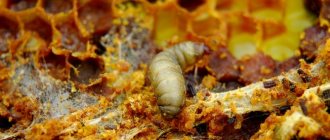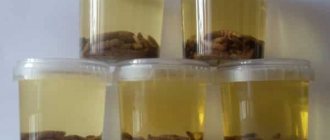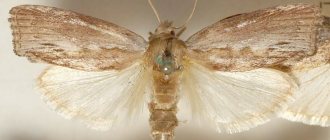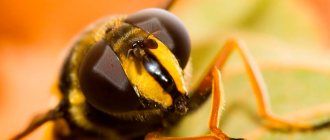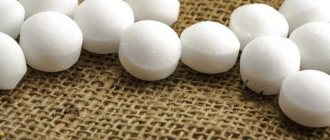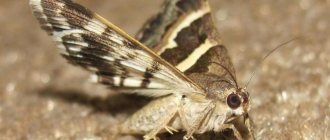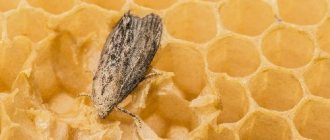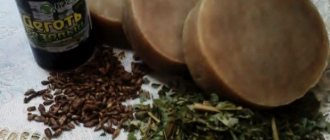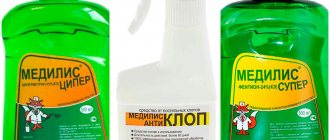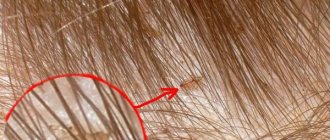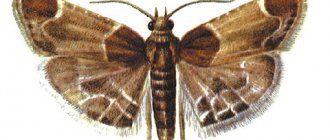Science is rapidly moving along the path of development, which makes it possible to create more and more new therapeutic drugs to combat various diseases. However, microorganisms harmful to humans quickly adapt to new drugs. Numerous laboratories around the world have to again look for ways to treat seemingly already defeated diseases.
Things are a little different when treating with folk remedies. Here the pathogens cannot yet decide to adapt and solve the problem of their survival. Why is this happening? No answer yet. Perhaps the rare use of such drugs does not allow pathogens to accumulate information and mutate. Perhaps nature itself has provided for everything so cleverly that, having placed natural remedies against bacteria and viruses in the hands of humans, it has blocked their ability to resist.
One of the most powerful folk remedies for the treatment of various diseases is bee moth tincture.
Who is the bee moth?
Beekeepers have one misfortune with which they constantly struggle. This is a wax moth. The name is collective for two species of these winged pests. Includes large (lat. Galleria mellonella) and small (Achroia grisella) wax moth. Both species are from the moth family (Pyralidae). That's why they are also called bee moths. There is also a poetic name - golden butterfly. That's what it was called in Ancient Greece.
It is not the butterfly itself that is harmful in the hive - it does not feed in this phase of development and lives off the nutrients accumulated by the larvae, but the worms that emerge from the eggs are a real scourge. Eggs are laid in the hive at night for several days in a row, after which the adult insect dies. After 5 days, larvae begin to emerge from the eggs. They are pale gray in color, about 1 mm long. In the first days of their existence, they eat honey and bee bread.
Important. If wax moth larvae are not dealt with, bee colonies weaken and die, or simply leave the hive.
As the caterpillars grow older, their diet expands - royal jelly, honeycomb and propolis are used. A few days before the transformation, moth caterpillars devour frames, insulating material, and even each other. Experiments have shown that these are the only representatives of the flora capable of eating and digesting polyethylene. During the experiments, holes appeared on the polyethylene film after just 20 minutes, and after 40 minutes the film almost completely disappeared. Caterpillars can digest chemically complex products such as wax and polyethylene with the help of special enzymes.
Interesting. The composition of the digestive enzymes of bee moths has not been fully studied. Various publications refer to the enzyme cerase. However, this enzyme is not mentioned in any scientific work. There is no chemical formula either.
After a month, having reached 2 cm in length, the caterpillar transforms into a cocoon. It is during this period, a few days before its transformation, that light yellow, sedentary and very voracious worms are collected, necessary for preparing ointments and tinctures at home.
What is a wax moth?
Wax moth, moth, melanium moth, bee moth, shawl - all these names refer to the same insect. The wax moth is a melonella butterfly from the wax moth family that lives everywhere, with the exception of regions with harsh climates, in the hives of wild and domestic bees. The length of an adult butterfly varies between 2-4 cm, the front wings are dark brown in color, the hind wings are lighter in color. The oral apparatus of an adult moth does not have a proboscis, so it cannot consume any food, and its vital functions are supported by accumulated substances. As adults, females live no more than 12 days, and males 26.
Moth moth
The butterfly lays eggs, which after 7 days turn into eight-legged moth larvae with a yellowish head and miniature sizes of 1 mm. As the caterpillar grows, the body length reaches 2 cm. Throughout the entire period, the larvae feed on waste products of bees: wax, beebread, and royal jelly. According to beekeepers, one melonella larva can destroy several hundred bee cells, and if the hive is heavily infested, bee colonies weaken or die.
Tincture recipe
The tincture of wax moth larvae is mainly prepared directly in the apiary. You can also prepare it at home. You just need to purchase the larvae of this butterfly and ethyl alcohol.
The caterpillars must be large. Some believe that it is necessary to remove them from the hive before pupation, others - a few days before transformation, and still others say that the age of the larvae does not affect the medicinal properties of the tincture. Practice shows that they are all equally right - the product works for all options for selecting caterpillars.
The alcohol must be at least 70% strength, although many folk healers use simple Russian vodka.
Preparation is simple: moth caterpillars are placed in a glass or ceramic container and filled with alcohol, after which the container is tightly sealed. Depending on the concentration required to obtain the final product, the ratio of the weight of the larvae to the amount of alcohol also changes. With a ratio of 1 to 10 we get a 10% solution, and 1 to 4 – a 25% solution.
Indications and contraindications for use
Like any other medical product, bee moth tincture has indications and contraindications for use. The use of the product gives good results in the treatment of respiratory diseases, the consequences of a stroke, hypertension, arrhythmia, chronic fatigue, cancer and many other diseases.
Tincture
However, the drug can cause serious harm. It should not be used by those who are allergic to bee products, children under 14 years of age, nursing mothers, pregnant women, and some other categories of patients.
Instructions for use
There is a general recommendation for using tincture of moth larvae. Should be taken either before meals, 30 minutes, or after meals, 1 hour. The extract should be shaken before use. Then there are three possible ways to receive it:
- Divorced. A few drops of tincture are mixed in 100 ml of water or tea (the dosage will be given below);
- Drops under the tongue and dissolves;
- It is taken similarly to Corvalol - from a spoon. After 1-2 minutes, swallow and wash down with water.
The dose depends on age, weight and type of disease, as well as the concentration of the drug.
When taking a 10% solution for preventive purposes to children under 12 years of age, the calculation is made in the ratio of 1 drop for every 12 kg of weight. For the first 2 days, the dose is reduced by 2 times. If no negative reactions of the body are observed, then proceed to the full volume. In adults it is 1 drop per 10 kg of weight. Taken once a day. Drink for 3 months, after which you should definitely take a break. The same applies to taking the extract as a medicine to treat various diseases.
Important. Traditional healers believe that it is prohibited to take a more concentrated solution before the age of 14.
It is recommended to treat diseases with a 20% composition. For tuberculosis, drink 6-10 drops for every 10 kg of weight, for cardiovascular diseases - 5-8, for male (prostate adenoma) and female (gynecological problems) diseases - 4-7, for bronchitis and asthma - also 4-7 drops. You should drink it in two doses: morning and evening.
An extract of a higher concentration should be converted into a 20% composition.
Methods of using the tincture
Tuberculosis
Consumption is treated with a gradual increase in the dosage of the drug. Start with a small dose - 3 drops/10 kg of weight, 3 times a day. The course of treatment is 2 months. While taking the drug, a patient with tuberculosis may experience side effects - strong sputum production, increased temperature. This is normal and there is no need to worry.
Weak immunity, chronic diseases
In case of low immunity, chronic pathologies, as well as after completing a course of treatment with chemicals, wax moth tincture is taken 10-20 drops half an hour before meals 3 times a day. The course of treatment is 3 months. Then be sure to take a break and repeat the treatment. Usually, to achieve the desired effect, 2-3 courses are necessary. If the patient feels relief after 1-2 courses, treatment should not be stopped. For a sustainable effect, you need to drink the tincture for another month.
Viral and infectious diseases
For these pathologies, the tincture is taken in the same way as for tuberculosis, for 2-3 months, after which a break is taken and then, if necessary, the course of therapy is repeated.
Recipe for fire ointment
When treating cuts, scars and colloidal scars, moth ointment is used. The following ingredients are used to prepare it:
- moth caterpillars – 25 g;
- vodka – 50 ml;
- wax – 25 g;
- propolis – 25 g;
- calendula oil – 100 g;
- St. John's wort oil or Aekol preparation – 100 g.
Step-by-step instructions for preparing the ointment: the caterpillars are poured with vodka and stored in a dark, cool place for 5 days, after which they are thoroughly mixed with the other ingredients. The resulting paste-like mass is simmered in a water bath for 2 hours. Cool and place in pre-sterilized glass jars. Place in the refrigerator for storage.
Mechanism of action of moth extract
The mechanism of action of bee moth extract is determined by the content of a variety of biologically active substances in the preparation, the most important of which are:
- Alanine - increases immunity and improves brain activity;
- serine - used by the body in the creation of protein structures;
- leucine - reduces blood sugar;
- aspartic acid has a beneficial effect on the treatment of somatic and depressive conditions in humans;
- proline - promotes the production of collagen, which slows down skin aging;
- valine— activates metabolism;
- glycine - ensures the existence of nerve cells and has a pronounced sedative effect.
Contraindications
There are general contraindications regarding the use of tincture of wax moth larvae. They provide for a ban on their reception:
- patients with hepatitis in the acute phase;
- persons with intolerance to bee products;
- persons coded for alcoholism;
- patients with pancreatitis.
The use of ointment is contraindicated in case of allergic reactions to wax and propolis.
Folk remedies made from moth larvae are a powerful biological preparation. It should be taken with caution so that the therapeutic effect does not turn into harm to health.
Useful and healing properties
The truly unique, multi-component composition of bee moth extract has determined its enormous benefits and beneficial effects on the human body. The drug can be recommended for both adults and children. The tincture is useful as a therapeutic, restorative and health-improving agent.
It has a pronounced healing effect on the human body:
- strengthening the immune system and increasing the body's resistance to infections;
- increasing the vitality of the body, mental and physical activity;
- normalization of sleep;
- improving the functioning of the nervous and cardiovascular systems;
- lowering blood cholesterol levels;
- normalization of blood pressure and reduction of the risk of thrombosis;
- rapid tissue regeneration, restoration of liver tissue in various forms of hepatitis, resolving effect on scar tissue, normalization of metabolic processes;
- activation of the process of hematopoiesis and the formation of red blood cells;
- protection of the human body from radioactive radiation, removal of heavy metals and products from salts during various intoxications;
- treatment of infertility (pregnancy), impotence (increases sperm motility), regulation of autonomic disorders during menopause.
From various diseases
This is not a complete list of all the healing possibilities of bee moth tincture, which are used today not only by traditional medicine, but also by professional doctors representing a variety of specialized areas of modern medicine.
It is not for nothing that wax moth tincture (moth) is called a remedy for many ailments - the more it is studied and used, the more wonderful properties it reveals.
The popularity of this product is growing every year. Just a few years ago, wax moths were considered only a dangerous pest of bee colonies, and few people knew about the healing properties of the tincture of its larvae. But today fewer and fewer people doubt its healing properties. Now moth tincture takes pride of place among bee products, and its production is a common practice for many beekeepers.
Wax moth - what is it?
Wax moth, also known as the bee moth, also known as Galleria mellonella, also known as the bee moth or cherries, also known as the wax moth, is a nocturnal moth, a parasite that feeds on the waste products of bees: honey, wax, beebread, bee pollen, propolis and, of course, wax honeycomb.
The bee moth is an insect completely adapted to living in a hive - it received its name “wax moth” because of its rare ability to digest and assimilate beeswax (one of the most inert substances in nature).
On the one hand, the wax moth is the beekeeper’s main enemy, because it destroys honeycombs with honey and beebread, pollutes them with waste from its vital activity, and if there is a lack of food, it literally gnaws even the walls of the hive and the insulation! Therefore, in the apiary, beekeepers wage an irreconcilable struggle with it.
On the other hand, many beekeepers know about the beneficial properties of its larvae and, if such a misfortune has befallen the hive, they will not miss the opportunity to prepare a healing tincture from them.
It should be said right away that in official medicine, wax moth tincture is known as wax moth extract. We are talking about the same drug, the only difference is in the name.
Tincture of wax moth (moth): from time immemorial to the present day
Tincture of wax moth (moth) was known back in Ancient Egypt - there they called it the golden butterfly. Priests and their wives used it to prolong youth and maintain attractiveness. Preparations of this insect were also used in the East - in Japan and Asian countries. In Rus' they also knew about the wonderful properties of the insect. How fire is used was described in the recipes of traditional healers. Already at the beginning of the 17th century, in ancient medical books, tincture of wax moth was mentioned as a means of treating consumption and senile infirmity.
The unique ability of wax moth larvae to digest wax (one of the most inert substances in nature) came to the attention of science at the end of the 19th century.
Nobel laureate in the field of physiology and medicine (1908) Ilya Ilyich Mechnikov was the first scientist to talk about the possibility of using wax moth tincture to treat tuberculosis.
Later, his student, Professor S.I. Metalnikov and foreign colleagues showed that the moth (wax moth) digests wax thanks to special lipolytic enzymes.
I.I. Mechnikov suggested that these enzymes are capable of breaking down the waxy shell of the tuberculosis bacterium. By acting on the lipid layer of the bacterium, the wax moth enzymes must destroy it and allow the immune system's own forces to destroy the damaged bacterium. On this principle, Doctor of Medical Sciences, Professor Annenkov G.A. and others, the “lipase concept” of tuberculosis has already been developed as one of the possible approaches to the creation of a new type of anti-tuberculosis drugs. In addition, wax moth extract currently acts as one of the most promising sources in the light of the creation of new highly effective and safe natural medicines (as opposed to synthetic ones, which have many side effects).
Tincture of wax moth (moth): medicinal properties, application
How is wax moth tincture useful? Numerous scientific studies, as well as reviews from those who took it, indicate that fireweed is effective for many diseases. And contrary to the opinion of skeptics who claim that it acts solely as a placebo, there are now a number of scientific studies that prove the opposite.
Wax moth larvae contain a lot of useful biologically active substances (BAS) . It has been proven that treatment actually occurs, although the mechanism of the influence of biologically active substances on diseases has not yet been studied fully enough to make it possible to create a real drug.
Scientists from the Institute of Theoretical and Experimental Biophysics of the Russian Academy of Sciences (Professor M.N. Kondrashova, N.A. Spiridonov, etc.), who received a patent for a method for producing wax moth extract, discovered the following substances in it:
- proteins and peptides (2%), including serine protease,
- free amino acids (50-60%),
- low molecular weight substances,
- lipids,
- carbohydrates,
Further studies showed that the extract has a wide range of biostimulating effects - it promotes tissue growth and oxidative metabolism, and is also characterized by adaptogenic and cardioprotective properties.
Work carried out at ITEB RAS by Professor S.I. Metalnikov and Professor I.S. Zlatogorov, show that the larvae have high immunity to a number of microorganisms (pathogens of tuberculosis, diphtheria, tetanus, plague, etc.), i.e. The tincture also has an antimicrobial effect.
Extensive studies of the wax moth and its medicinal properties were carried out by V.F. Bakaneva, Candidate of Biological Sciences, as part of her PhD thesis “Biologically active substances from GALLERIA MELLONELLA larvae and bee waste products as potential cardioprotectors and adaptogens under the influence of hypodynamic and stress factors on the body of experimental animals and humans »
The scientist made a number of interesting discoveries and conclusions:
- Wax moth (moth) extract contains antibacterial peptides - natural antibiotics with which insects fight pathogens and pathogens. Antimicrobial peptides act faster than conventional antibiotics and destroy bacteria that are beyond their control. At the same time, there are no toxic or damaging substances in the extract.
- Wax moth extract has a pronounced cardioprotective and anticoagulant effect, causing an improvement in aerobic processes in the vascular wall of the aorta. Ognevka stimulates the contractile activity of the heart by 55%, the atria by 20%, and the myometrium by 80%. The extract reduces blood pressure after exposure to stress factors by almost 17%.
- A serine protease enzyme was isolated from wax moth extract, which is capable of not only dissolving the shell of tuberculosis bacteria , dissolving myocardial scars, stimulating the growth of new cells, but also accelerating the regeneration of neurons.
- The extract contains γ-aminobutyric acid, acetylcholine and serotonin - these substances have an anti-stress effect.
According to Candidate of Biological Sciences E.S. Ostanina, as part of her PhD thesis “Technology for processing wax moths, studying the anti-tuberculosis properties of chitosan and its interaction with lipolytic enzymes,” chitin and chitosan are present in the extract of moth larvae. These substances regulate lipid metabolism , i.e. the extract has lipolytic activity. This means that wax moth is useful for atherosclerosis, diabetes, and obesity. Chitosan also has antimicrobial properties and anti-tuberculosis activity.
So, wax moth tincture (extract) is a cure for many diseases. It is indicated for the following diseases or conditions:
- Tuberculosis
- Oncology
- Cardiovascular diseases - angina pectoris, arrhythmia, ischemia, consequences of heart attacks, aortic aneurysm
- Bronchopulmonary diseases
- Atherosclerosis, diabetes, obesity
- Infertility, diseases of the reproductive system (male and female)
- Respiratory infections
- Prevention or enhancement of the body’s adaptive capabilities under conditions of stress, increased physical and emotional stress
- Prevention of premature aging
You can read more about the use of wax moth tincture for various diseases in our brochure Wax moth - application - instructions, separately about the treatment of tuberculosis - in our other brochure Tuberculosis - treatment with wax moth extract.
Reviews of fire treatment can be read here.
How to choose and buy high-quality wax moth tincture
Where is the best place to buy wax moth tincture? Only from trusted beekeepers who use special food that is as close as possible to all the natural products that the bee hive contains. These are dark wax honeycombs containing honey, bee bread, and the honeycombs are clean, without mold, recently removed from a hive with bees. Unscrupulous sellers grow moths on waste from wax melting (merve), the remains of old moldy honeycombs, artificial food - such a tincture, of course, will not have any beneficial properties.
Beautiful packaging and even a certificate for a product are not a guarantee of quality. The certificate will not tell you whether the contents of the bottle have medicinal properties. The certificate only indicates the absence of compounds harmful to humans. And there is no talk about benefits.
If you decide to buy wax moth extract, be sure to look at the bottle (or its photo) - it should be made of dark glass and contain only whole larvae inside. If the bottle does not contain larvae, you will not be able to check their quantity, that is, whether the stated concentration on the label corresponds to the real one. And therefore you will not be able to correctly calculate the dosage of use. Without larvae, you can only buy moth from a reliable seller, this eliminates the need to strain and pour the extract.
And one more piece of advice. Don’t go cheap – creating optimal conditions for growing moths, high-quality food, and manual collection and sorting of larvae cannot be cheap. The low price of wax moth tincture is a reason to be wary. Focus on 500-600 rubles per bottle, this is an adequate price for the fire.
Wax moth tincture - application (brief instructions)
The method of using wax moth tincture (moth) depends on many factors: disease, body weight, individual tolerance, etc. The ideal option is to ask the person from whom you are buying it to write down the course of treatment. If you choose a truly competent beekeeper, he will definitely be able to tell you about the method of using wax moths specifically for you.
Moth tincture can be made with different concentrations. The higher it is, the fewer drops you need to use.
Approximate amount for a three-month course (10% concentration of larvae): 3 bottles of 100 ml. with a weight of 50-60 kg, 4 bottles of 100 ml. with a weight of 70-80 kg, etc.
More detailed information can be found here.
Wax moth tincture: contraindications
Contraindications to the use of the tincture are as follows: individual intolerance to the product, allergic reactions to bee products.
Now you know almost everything about wax moths!
It's time to try this miracle remedy and see if it really works!
We are beekeepers with more than twenty years of experience, we work in a family apiary (about 100 hives), we produce moth tincture and other beekeeping products. The apiary is located in a clean area, on the shore of the Krasnoyarsk reservoir.
We produce the wax moth tincture on dark sushi using the patented technology of the Russian Academy of Sciences, we control all stages of production, we select the best larvae by hand and immediately fill them with extractant (we do not freeze them, we do not dry them), we pour the product into dark glass bottles to protect them from any influences. That is, we get an absolutely natural product of high quality.
By purchasing wax moth tincture from us, you can rest assured of its effectiveness. Just try it and the result will definitely please you.
You can place an order directly from the site.
Or call us at 8-800-511-06-80 toll-free and 8-983-207-49-88 to place an order and consult.
How is moth tincture useful?
If we look at statistics, in the 19th century every 7 inhabitants died from transient consumption in Europe. And in the 20th century, the disease continued to remain the most common in the world. The disease is caused by tuberculous microbacteria, which most often affect the respiratory organs, although in practice tuberculosis of the joints, bones, eyes, genitourinary organs, and peripheral lymph nodes occurs.
Since the bacteria that cause tuberculosis are covered on top with a shell similar in chemical composition to wax, it has been suggested that an enzyme called cerrase, contained in the digestive tract of wax moth larvae, which helps them absorb wax as food, can also successfully affect the outer shell of the tuberculosis moth. sticks, split it and destroy it.
The belief about the unconditional usefulness of this drug for the treatment of tuberculosis is based on this assumption. The use of a tincture containing special enzymes of bee moth larvae helps in the resorption of focal changes. And numerous reviews from patients who have used the healing drug confirm the fact of its positive effect on the treatment of this serious disease.
However, scientists do not confirm the existence in biochemistry of such a substance as cerrase. And the fact of death of the tuberculosis pathogen in the human body under the influence of this enzyme is also not confirmed by reliable data. Nevertheless, the popularity of bee moth tincture in alternative medicine is constantly growing; its new healing properties are being experimentally discovered, thanks to the extraordinary biomaterial from which it was prepared.
Chemical analysis of the raw materials confirmed that moth larvae contain a lot of useful substances with excellent antioxidant and stimulating properties, which make it possible to use medicinal products prepared on their basis in the treatment of various diseases.
The main part of bee moth extract consists of amino acids:
- Alanine – good for the brain;
- serine is an essential component in the synthesis of many natural proteins;
- valine – affects the immune system;
- a group of amino acids that inhibit the aging process and promote rejuvenation of the body.
In addition to amino acids, the tincture contains trace elements, fatty acids, monosaccharides, and unique enzymes that can digest wax and destroy the protective coating of bacteria.
According to patient reviews, regular use of this product:
- improves the functioning of internal organs, the immune system, blood circulation, metabolism;
- promotes the healing of scars, cicatrices, abrasions;
- recovery processes occur faster in the body, hemoglobin and red blood cells return to normal;
- muscle work is stimulated, wrinkles are smoothed out;
- blood pressure decreases;
- stress is relieved, sleep is stabilized, vital activity and performance increase;
- the effect of steroidal anti-inflammatory drugs is mitigated.
